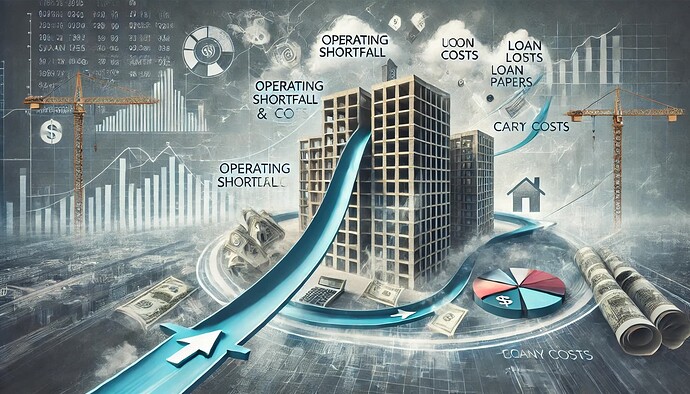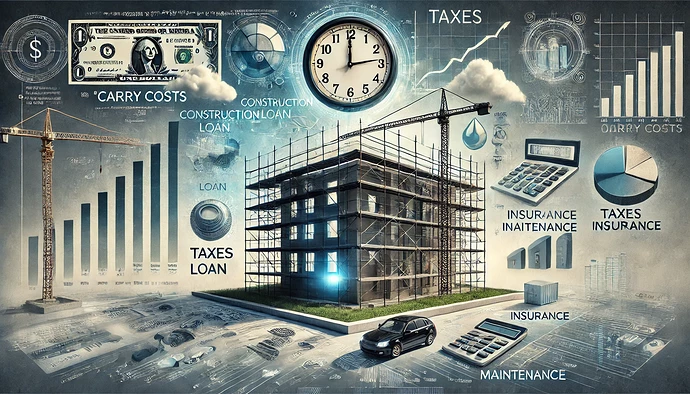In real estate financial modeling, Operating Shortfall and Carry Costs are critical concepts when evaluating development or investment projects, particularly during the development, stabilization, or lease-up phase.
1. Operating Shortfall
Concept:
An Operating Shortfall occurs when the income generated from a property (or development project) is insufficient to cover its operating expenses. This usually happens during the early stages of a project when rents or income have not yet fully stabilized or when the property is not fully leased.
This shortfall often arises in the lease-up phase of a new development or when repositioning an underperforming asset. The shortfall is typically funded by additional capital (equity or debt) to ensure that the property can meet its financial obligations until it reaches a stabilized level of income (usually 90-95% occupancy).
Calculation:
Operating Shortfall = Operating Expenses - Operating Income
- Operating Expenses include property management fees, maintenance costs, utilities, insurance, property taxes, etc.
- Operating Income is primarily rental income from tenants and any other revenue streams generated by the property.
Example: Suppose you have a property with:
- Monthly operating expenses of $50,000
- Monthly rental income of $30,000 (in the lease-up phase)
Operating Shortfall = $50,000 - $30,000 = $20,000
This $20,000 deficit must be covered until the property is stabilized and generating enough income to cover its expenses.
Does operating shortfall cover all shortfall before the permanent loan kicks in?
Yes, the Operating Shortfall in real estate financial modeling typically covers all shortfalls before the Permanent Loan kicks in, but only up to a point.
Here’s a breakdown of how it works and what it covers:
1. Development and Lease-Up Periods:
During the development and lease-up periods of a real estate project, the property is often not generating enough income to cover all its operating expenses, debt service, and other carrying costs. This phase typically involves funding the shortfalls through various means such as:
- Equity Contributions: Initial equity provided by investors or developers.
- Construction Loans: Loans that cover the construction and sometimes initial lease-up costs, often including an interest reserve.
The Operating Shortfall usually refers to the deficit between operating income and operating expenses during the lease-up phase (or the period before the property reaches a stabilized income level).
2. Permanent Loan Phase:
The Permanent Loan generally replaces the construction loan once the property has reached a certain level of stabilization, often defined by the lender as 90-95% occupancy. This is the point when the property’s income is expected to be sufficient to cover operating expenses, debt service, and other financial obligations.
However, before the permanent loan is in place:
- The Operating Shortfall covers any deficit between operating income and operating expenses.
- The construction loan (or other short-term financing) may also include an interest reserve that helps cover the debt service until the project reaches stabilization.
3. Does the Operating Shortfall Cover Everything?
While the Operating Shortfall concept primarily addresses the gap between operating expenses and income, it does not necessarily cover all costs before the permanent loan kicks in, specifically:
- Debt Service on Construction Loans: Sometimes this is covered by a separate interest reserve, which is built into the construction financing. The operating shortfall itself generally does not cover interest payments on loans unless structured that way.
- Construction-Related Costs: If there are construction delays or cost overruns, these expenses are typically not part of the operating shortfall but are instead covered through additional capital contributions or loan draws.
- Carry Costs: Some carry costs like property taxes, insurance, and utilities may be covered by the operating shortfall. However, if these are structured separately, they might require their own funding mechanisms.
Conclusion:
The Operating Shortfall specifically covers the shortfall related to operational income versus expenses before stabilization but does not cover all expenses before a permanent loan kicks in. To fund the project through the lease-up phase and ensure the property reaches stabilization, both the operating shortfall and carry costs (including any debt service on short-term loans) need to be addressed.
Therefore, a combination of construction loans, equity, or bridge financing is typically used to cover all shortfalls, including operating shortfalls, carry costs, and any pre-stabilization debt service.
2. Carry Costs
Concept:
Carry Costs refer to the expenses associated with holding or owning a property during its development, lease-up, or transition period before it becomes income-generating. These are the costs incurred when a property isn’t fully operational or stabilized, and they include financing and ownership costs that continue regardless of whether the property generates income.
Carry costs are critical to account for, as they can significantly impact the overall returns of the project.
Components of Carry Costs:
- Property Taxes: Ongoing taxes that must be paid on the property, whether it is fully developed or not.
- Insurance: Premiums to cover property insurance.
- Financing Costs (Interest and Fees): Interest payments on loans taken to fund the development, construction, or purchase of the property.
- Utilities and Maintenance: Basic maintenance, utilities, and security costs for keeping the property functional during development.
- Legal and Administrative Costs: Costs related to regulatory approvals, legal fees, and other administrative expenses during the holding period.
Calculation:
Carry Costs = Financing Costs (Interest) + Property Taxes + Insurance + Other Ownership Costs
Example: For a development project, assume the following monthly carry costs:
- Interest on construction loan: $25,000
- Property taxes: $10,000
- Insurance: $5,000
- Utilities and maintenance: $2,000
Total Carry Costs = $25,000 + $10,000 + $5,000 + $2,000 = $42,000 per month
These carry costs accumulate during the development phase and need to be factored into the project’s budget and cash flow analysis. They continue until the property is stabilized and income-generating.
Combining Operating Shortfall and Carry Costs
When evaluating a development project, the total required funding before stabilization includes both the operating shortfalls and the carry costs. This combined value often needs to be financed through construction loans, equity contributions, or other financing methods.
Total Funding Requirement = Operating Shortfall + Carry Costs
These elements are critical in cash flow forecasting for real estate projects, ensuring that you have enough capital to sustain the project until it reaches stabilization and becomes cash-flow positive.

